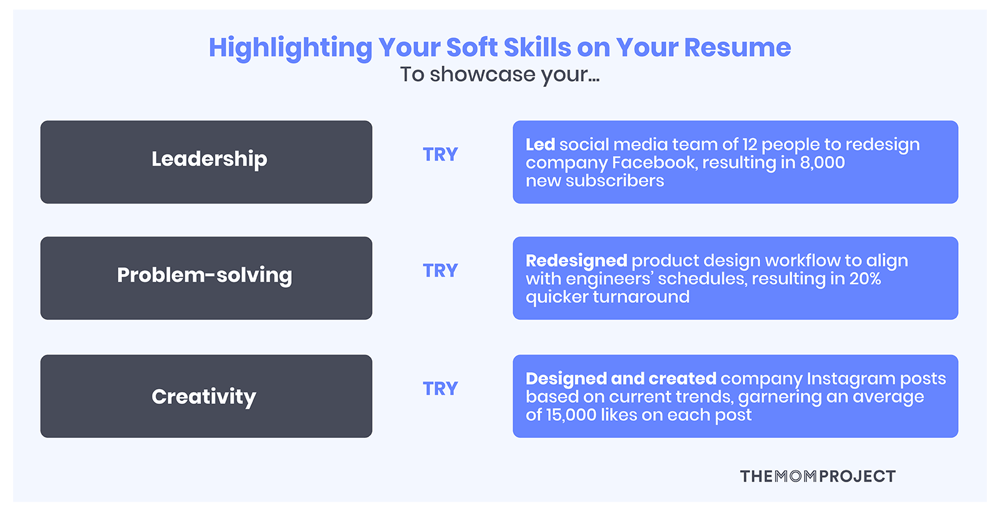Out of all of the steps in the job application process, from interview prep to salary negotiations, your resume is the very first thing to grab a recruiter or hiring manager’s attention. There’s a lot riding on that tiny document, so it’s worth putting in the time and effort to get it right.
On average, 250 people will apply to a job posting, with only 4-6 candidates called in for an interview and only one will be hired. So it’s important to craft a resume that will stand out among a talented pool of competitors.
The resume-writing process can seem especially daunting on top of all of the responsibilities you’re already juggling—whether it’s your kids’ activities, online classes or your current job. And for moms re-entering the workforce after a hiatus, there’s the added challenge of figuring out how to be transparent about your break without diminishing your value as a candidate.
So, let’s talk about how to build an eye-catching resume that will:
- Give employers a snapshot of your skills and experiences that make you the right fit for the role
- Convince them to move you on to the next step
- Own your career pause and use it to strengthen your application
Format and design
First, choose a format that best suits your career background and industry. The most commonly-suggested resume layout is the reverse chronological format, which emphasizes work experience, with the most recent position at the top working your way backwards.
If you feel like you have too little work experience to show, or if you’re reentering the workforce after a long career pause, you can opt for a combination resume. A combination resume emphasizes both your technical skills and work experience, so you can still showcase your strengths if you’re less confident about your professional history. You can also include a professional summary to introduce yourself as a candidate and talk about what you’ve been doing during your pause.

Non-traditional resumes or custom-designed resumes can help you stand out, particularly if you’re applying for a job in a creative field like marketing or fashion. But be careful not to overdo it. Applicant tracking systems, which are used by 75% of large companies, can’t always read heavily-designed resumes, so overly-complicated formats will often be automatically rejected.
👉 When in doubt, opt for clarity and readability. If you’re trying to show off your skills as a graphic designer or an artist, attach your design portfolio so the hiring manager can get a sense of your work.
Gathering the information
Professional resume writer Ashley Cash says that the three most important adjectives that your resume should embody are searchable, specific and scannable.
Searchable
Your resume should mirror the job description. This will make it clear to both an applicant tracking system (ATS) and a human reader that your skills and experiences will translate well into the role. But don’t copy/paste any bullet points from the job description or mimic it completely. Go through the qualifications and requirements described in the job posting and highlight any keywords and phrases that seem important to the position.
Make sure those keywords are included in your resume, along with specific accomplishments and experiences to back them up. Leaving out proper context could make it look like you're keyword stuffing, and hiring managers will pick up on that.
👉 To save yourself some time and avoid writing the same bullet points over and over again, keep a master list of all of your professional experiences and skills to pull from for each resume.
Specific
Include only skills and experiences that are relevant to the job to which you’re applying. As tempting as it can be to show off all of your amazing accomplishments, too many items can crowd your resume and water down the rest of your points.
One strategy that could make this easier is creating customized resumes for at least 1-2 general career paths to highlight only the most relevant qualifications for each position. Then, for each job description that you’d like to cater your content to, go through and edit your starter resume to make it more specific to that posting.
Scannable
Try to keep your resume to a maximum of 1-2 pages (a little bit over is fine, but three is overkill). A recruiter or hiring manager will only spend about an average of six seconds looking over each one before making a decision, so it’s important to make your most impressive qualifications easy to find.
Think carefully about the order, with the most relevant content closer to the top. Then, make sure you choose a font and spacing that’s easy to read.
▶️ Watch: Unity Hour - Resume Redux with Ashley Cash for more insights and best practices to build your strongest resume.
Personal information
You have a lot of flexibility on how to format your contact information, as long as it’s easy to find. Make your name nice and bold at the top of your resume, and be sure to include your phone number, email address, LinkedIn profile and any other relevant, professional social media accounts.
You don’t have to include your home address, but it might be helpful if you live in the same area as the office so the recruiter can see that you wouldn’t cost extra for relocation if you were hired.
Research shows that 76% of resumes are discarded for having an unprofessional email address, so use an account with a professional, easily identifiable address, like jane.smith(at)yourmail.com (but don’t use the business email of your current employer!)
Work experience
Unless you’re a new graduate, work experience should be more prominent than education on your resume. If you have a long list of positions to choose from, try to narrow it down by what’s most relevant to the job posting. Also, don’t forget to include any freelance or volunteer work that can showcase a strength or technical skill you picked up.
Building each bullet point
Try to limit each position to a maximum of 5-8 bullet points, and keep it relatively consistent across the board.
👉 You don’t have to rely only on your memory for ideas! If you’re having trouble figuring out what to write, consult your old performance reviews for inspiration.
Every bullet point should answer two questions:
- What did you do? Talk about the projects you did, the people you worked with, and the processes you used. Be sure to keep formatting consistent by starting each point with a power word like led, managed, organized, planned, presented, etc.
- What was the impact?: This is a good place to bring in some numbers. Did your content bring in 15,000 Instagram subscribers? Did you decrease the budget by 27%? If you don’t have these metrics, no worries! You can substitute by getting more specific with details-- talk about the project count or the audience that your work affected.
Remember that your resume should be telling a story. Organize your bullet points to reflect your career development. You can draw attention to promotions by listing each title, along with its responsibilities, separately under a single company.
 Rethinking Your Resume to Highlight Your Accomplishments
Rethinking Your Resume to Highlight Your Accomplishments
Highlight your achievements instead of your responsibilities to provide a more accurate picture of your experience and skills.
Owning your career pause
It’s perfectly normal and acceptable to take a career pause—whether it’s to be with your family or a period of unemployment after a layoff. However, we know that your career pause can also be a source of anxiety. That’s why it’s important to address your pause clearly and confidently in your resume. All you need to include are the start and end dates, along with a quick description of the reason you took the pause (if you’re comfortable sharing).
Our resume-building tool Resume Rev makes this even easier, with a feature designed specifically for creating this section.

Education
Unless you’re a recent graduate or pursuing academia, you don’t need to dedicate too much time or space to this section. You don’t need to tell employers when you graduated, but it could help to explain more modest work experience if you’re only a few years out of school.
Whichever way you decide to do it, make it clear if you did graduate (include the degree you earned) or if you didn’t (use a phrase like “in progress”).
Feel free to leave off your GPA, but include any honors or awards you received during your program. Also make sure you list any certifications or online classes that could be relevant to the position.
Skills
Your skills section is a good way to show employers that you can handle specific tasks or technologies that the role requires. However, it also runs the risk of reading like a laundry list, and the hiring manager may accidentally skim over important information. To make it more readable, try dividing your skills by category (language, software, etc.)
On top of that, try to narrow your skills down by whatever’s most relevant to the position. If you need a starting point, do a quick Google search of the top ten skills for your industry, as well as a scan through the requirements listed in the job description. Then include any skills you have out of that list—first in the work experience section (where you explain how you used it) then again in the skills section.
While soft skills are important to employers, now is not the time to list them out. Recruiters will typically be able to get a sense of your communication and presentation skills from a phone interview, so there’s no need to say it explicitly. However, you can still use your resume to demonstrate your soft skills by weaving in certain phrases.
For example, if you want to bring up your leadership skills, write a bullet point about a project you led.

Using your online presence to supplement your resume
Keeping your resume to 1-2 pages (remember the six second rule!) may not capture everything you want your employer to see. This is where you can take advantage of online tools, like LinkedIn or a personal website, to showcase specific projects and achievements.
Unlike your resume, you probably won’t be able to cater your LinkedIn profile to fit every job you apply to. However, you can (and should) make sure it includes all of the experience listed on your resume, including a career pause if you have one. Also keep in mind that even social media accounts that you don’t provide with your application may be searched by employers, so make sure any content on your public accounts is tasteful and work appropriate.
Check your work
Proofread, proofread, proofread! Research shows that between 61-76% of hiring managers will reject a resume based on one or two typos, so make sure your resume is flawless. Consistency is key, so double check that any formatting (bolded titles, italics, etc.) follows the same standard throughout the resume. It also helps to have a pair of fresh eyes, so get a friend or a previous colleague to look over it as well if you can!

You’re all set!
Once you’re confident that your resume accurately reflects your qualifications and why you’re a good fit for the job, you’re ready to send it out.
👉 Pssst...Looking for more? Sign up for our 5 Day Resume Challenge! We'll send a daily challenge directly to your inbox for five straight days so you can level up your resume.
Find career opportunities with vetted, family-friendly companies
Join our talented community of moms and mom allies. Whether you’re searching for your next opportunity, looking to give or get career guidance or just getting started—you’re in the right place. 



